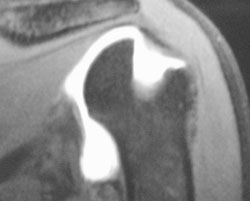Surgeon shares tips and tricks to using bone procedures for unstable shoulders
At Orthopedics Today Hawaii 2012, Christopher S. Ahmad, MD, discussed when surgeons should opt for bony-type procedures in the face of shoulder instability and his techniques to performing these procedures.
“Several years ago, a session dedicated to instability would often revolve around open surgery vs. arthroscopic surgery,” Ahmad said in the presentation. “Now, the discussion is more soft tissue surgery or bony-type procedures.”
Patients with bone deficiency or bone involvement with their instability may have sustained their injuries from a high-energy trauma or have history of a large number of instability events, Ahmad said. Surgeons should consider potential bone deficiency in patients who have failed previous surgeries. Another suggestion of bone deficiency is progressive worsening of apprehension symptoms and at less extreme ranges of motion.
Imaging and bone loss
During the evaluation, Ahmad said that orthopedists should look at not only X-rays, but also advanced imaging. While X-rays can reveal Hill-Sachs lesions and anterior glenoid deficiencies, MRI can detail labral pathology and bone involvement. If bone deficiency is suspected, Ahmad requests 3D-CT reconstructions which allow surgeons to “quantitate accurately the amount of bone missing.”

MRI scan of patient with seizure disorder shows massive humeral head deficiency.
Images: Ahmad CS
Missing bone can also be quantitated using diagnostic arthroscopy and examination under anesthesia, Ahmad said. Calibration probes may be used to quantitate bone loss. He noted a study conducted by Burkhart and colleagues that defined a bare spot at the center of the glenoid from which surgeons can measure to gauge instability. A study by Itoi and colleagues noted a critical limit of 6 mm to 7 mm of glenoid bone loss, about 20%, for “dramatic loss of stability,” Ahmad said. Patients with 8 mm to 9 mm of bone loss, at least 30% to 40%, and will experience the most instability problems, he noted. Orthopedists can treat patients with mild levels of bone loss at 3 mm to 4 mm (less than 15%) with a standard operation.
“There is a gray area — 15% to 30%,” Ahmad said. “This is where it depends. It depends on what they do, what kind of athletes they are and what kind of demands they have on their shoulder.”
When a patient has high frequency instability or ability to self reduce, orthopedists should check for bone deficiency or extreme capsular stretch and counsel the patient for a possible coracoid transfer, Ahmad said.
Another alternative is to use the Latarjet technique. Coracoid procedures require bone preparation both on the anterior glenoid neck and coracoid, exact coracoid positioning and good fixation to avoid failure.
“Of course, with these open approaches, you have to make sure you repair the subscap if a tenotomy is performed. Alternatively, a subscap splitting approach can be utilized and provides adequate exposure and perhaps less morbidity,” Ahmad said.

Open approach with exposure of humeral head demonstrates massive humeral head deficiency.

Humeral head allograft placed to manage humeral head deficiency.
Humeral head impression defects
For instability of a humeral head impression defect, Ahmad has an algorithm. If the defect is mild or less than 20%, he recommends standard anterior soft stabilization. If the defect is 20% to 30%, he recommends anterior stabilization and will consider bone augmentation on the glenoid, especially if mild anterior glenoid deficiency co-exists. For defects at 30% to 45% bone loss, he uses anterior stabilization combined with osteochondral humeral allograft. Those above 45% or those with concern that bone osteochondral grafting will fail to heal require prosthetic replacement.
“Humeral head impression defects also can be managed with a procedure called the so-called remplissage, where you can arthroscopically suture the infra into the lesion,” Ahmad said. “In an acute impression humeral defect, there has been some discussion about disimpacting it acutely and bone grafting. I have done some osteochondral grafting arthroscopically. However, [for] the largest lesions which in my practice is most commonly observed in patients with seizure disorders, we have seen great success with large osteochondral humeral head allografts. For the big ones in older patients or patients with compromised bone graft healing capacity, you should start to consider prosthetic replacement.” – by Renee Blisard
Reference:
- Ahmad CS. Bone procedures – When, why and how? Presented at Orthopedics Today Hawaii 2012, Jan. 15-18. Wailea, Hawaii.
- Itoi E, Lee SB, Berglund LJ, Berge LL, et al. The effect of a glenoid defect on anteroinferior stability of the shoulder after Bankart repair: A cadaveric study. J Bone Joint Surg Am. 2000; 82:35-46.
For more information:
- Christopher S. Ahmad, MD, can be reached at Columbia University, Center for Shoulder, Elbow and Sports Medicine, 622 W. 168th, New York, NY 10032; 212-305-5561; email: csa4@columbia.edu.
- Disclosure: Ahmad receives basic science support from Arthrex, Arthrotek and Smith & Nephew, and is a consultant for Arthrex and Acumed.

